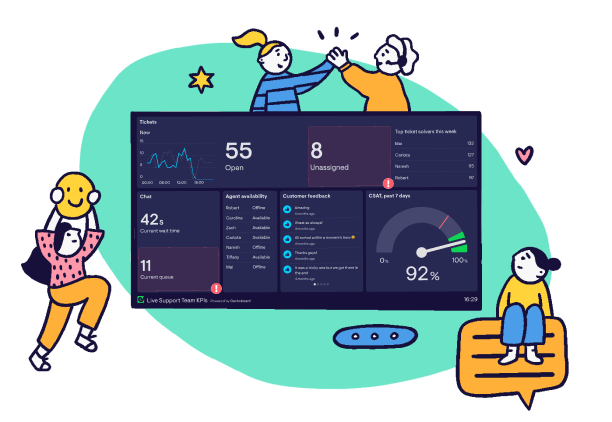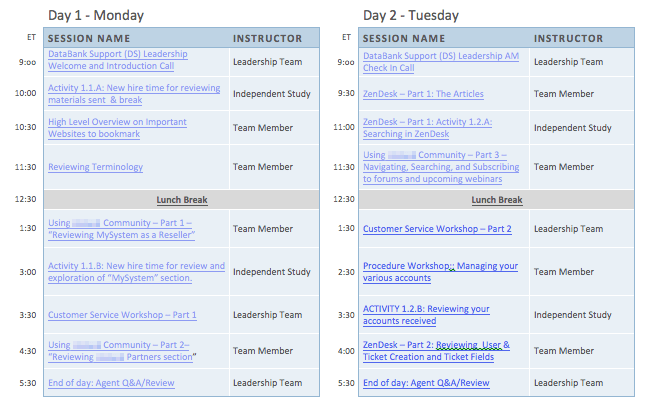This is the first part in our new mini-series of stories from unsung heroes on the front lines of customer support management, who share what has helped them succeed in their role.

Hero: Cory Archer
Years in CS: 16
Current job title: Director of Support
Company & type of support: DataBank IMX, a 700-people strong business process solution provider, with a dedicated support team looking after 15 different software packages, troubleshooting complex issues in medical, financial and payables environments.
Team size: Entirely distributed team of 16: 1 manager, 3 team leads, 12 agents.
Service hours: 8am-8pm, with 24/7 emergency support.
Tickets per month: 700-800.
Channels: Phone, email and portal.
When I heard that the CS team at DataBank consider themselves to be a ‘family’ and jokingly call their director ‘Dad’ and the manager ‘Mom’, I began to understand that there’s something distinctly unconventional about this department, nestled as it is among more traditionally corporate departments.
So who’s behind this outlier?
His name is Cory Archer – twice over entrepreneur and former implementation engineer with a high school diploma and no university degree, who made himself a career in support and decided he was going to run things differently.
Cory simply looked at the things he didn’t like in his previous jobs and set out to create something better, something that wasn’t going to be unpleasant for the team or customers and as a consequence not unpleasant for him either. So he kept all the best parts of what he’d experienced and then he simply started designing processes around the humans he was working with.
Cory says: “It can be easy to get labeled as the one who's too emotionally invested in the team in this line of work and then I always point out that, as the person in charge of the customer experience, that's quite ironic to be saying.”
Block & tackle management
A customer support team is only as strong as its people – and it’s your people that cannot be replicated and that set you aside from the competition – so Cory takes his responsibility of keeping his team happy very seriously.
“I’m a very involved, hands-on manager. Our CEO is going to come talk to me to understand the business and team needs, not to the individual agents, so it’s super important that I know what challenges the team is facing and what customer behaviors we’re seeing. I stay close to it by regularly taking calls myself because the reality is that our employees don't always tell us what they're seeing on the front line, no matter how open the environment. So I’m very involved but no micro-manager.”
Every two months, he will sit down with each agent to check in on how they are doing and ask questions like “How can I make your day better? What can I get out of your way?” He says he blocks and tackles for his team. It doesn’t matter if it’s a perception of someone (even an executive) being difficult internally or a customer having problems. He sees it as his job to fight the battles and get these obstacles out of the way so the agents can get back to loving what they do and making customers happy.
This approach also reveals future senior agents and leaders because they are the ones who say: “What you do for us is great, and I want to learn how to do it for the rest of the team. Teach me how to have those conversations. Teach me how to block and tackle.” They already come into it with an appreciation for what it felt like to have somebody looking out for you and they want to do the same.
Letting the numbers talk
People in the US tend to have low expectations of customer support and the individuals who provide it, and unfortunately that creates some natural bias. To challenge the misconceptions about support at DataBank, Cory found that calling out statistical differences worked well when trying to get the attention of executive leaders and senior leadership teams, basically people who communicate a lot in numbers, to unify a strong message about DataBank’s approach to support.
“Maintenance revenue is a reflection of our relationship with our customer, and that’s important to DataBank, so to me CS definitely doesn't feel like the outlier or starter team it can be perceived to be at some companies. When I can get the execs really invested in that message, they can filter it down to the rest of the company and use it to position us in the market. We put our money where our mouth is to ensure we’re at the top of our industry.”
Once he had their attention, he began explaining to them how the sometimes poor perception of CS can impact his team and how everyone at DataBank could take on this challenge. Cory used numbers to appeal to the senior leadership by reminding them of new hiring costs, recruiter time, training costs, position posting, leadership timeout and so on to validate the importance of employee retention. On the customer front, messaging about the long term relationship DataBank is striving for and its commitment to a dedicated team improved the overall customer experience, call times and resolution times.
The senior leaders really got it and got behind him, which hugely helped turn around the narrative to the CS department being the ones doing things right and retaining people and keeping them and customers happy.
“Two restaurants can serve steaks but you're going to go to the one that serves the good food and has the great service, the one where the waitress remembers you and greets you when you come in. You're not gonna go somewhere with terrible people just because the food is good. Similarly, I think more businesses would flourish if they just brought back the humanity to what they do.”
Contribution versus output
Customer support is a tricky environment because it’s quantitatively measuring highly qualitative work and Cory wanted to adopt a human approach to these metrics-driven tasks so he thought a lot about which metrics would show the value of an agent’s contribution rather than their output.
“In business today, everything is treated like a fast food restaurant experience. The mark of good service is that you got the bag in the drive-through window and they drove away and it was under one minute. So what if you spilled the drink as you slammed it into their car window?”
The metrics that Cory shares with the team on his Geckoboard are designed to drive that human element and are always pitched at how the agent is investing in the team effort:
- How long is it taking other teams to help us help our customers?
- How long is it taking us to get answers to our customer?
- What's the customer feedback that we've been getting for the past weeks?
- How many cases have we worked through successfully as a team?
“The live Geckoboard TV dashboards are there to help people help each other because agents can support each other when they see someone’s volume is up. Our guidance to the team is ‘make the customer happy to the best of your ability’ so if someone closed four out of five tickets and the customers are all very happy, why should that agent be penalized for not closing more tickets? We’ve shied away from things like case closure rates but we do watch our resolution time.”
Metrics for Humans
Cory believes that as a leader, it’s his responsibility to be able to give people the ‘why’ – everything from why the department is the way it is to why things are done a certain way – in order to get stronger buy-in.
"I’ve made my metrics people-based and it’s been incredibly successful. So if an agent asks me ‘Why do we track first response time?’, I can say ‘Because I need to know that you have a manageable workflow and know we’re acknowledging people in a human way.’ If they say ‘Why do we track the resolution times?’, I can say ‘Because I need to know that we have enough people so that you can have a good day and our customers are taken care of.’ The numbers still mean the same thing. A CEO doesn't necessarily care that I'm happy because my people are happy. He wants to know that we're making our first contact in under 30 minutes, which gives a marketable value of working with our company to current and prospective customers – that makes us all happy.”
Give your support team a boost
With Geckoboard’s real-time dashboards, everyone knows exactly what’s happening in CS right now.
Find out more
Tickets + Case management = Happiness
A CS agent will always have an area of interest and expertise and doing what you’re passionate about tends to make a person happy, so it’s only logical that agents be allowed to use that knowledge while also contributing to the team, not to mention that it makes for the best customer experience.
To administrate this, the CS leadership team share a role called case management where one of them is always on duty to keep an eye on case volume and to distribute tickets to the most suitable agent. There is a reference spreadsheet that will show every agent’s self-rated score for each module, making it easy to pick out the subject matter experts. Cory is also in the process of moving operations to Salesforce and Service Cloud, which means the Case Manager will be able to leverage AI to find the right match. Agents’ strengths, weaknesses and case history are all tracked for this reason but also to flag where additional training is needed.
Senior agents also do case management. Not only will this show up those who have leadership potential, but the more people who understand the capabilities of the team, the more successful the team becomes, because when an agent doesn’t know something, they’ll know who does. This goes back to the emphasis on team metrics over individual metrics as a sign of success.
Onboarding – Resistance is futile
When hiring, Cory rates a cultural fit and entrepreneurial spirit over certifications and technical credentials since the latter can easily be taught.

“We’re like the Borg in the Star Trek series. We assimilate you and your distinctiveness will be added to our own,” Cory says about his onboarding process. “The first thing we tell a new starter is that the one thing our competitors can’t replicate is our people, so they know from the beginning how valued they are. Then we take them through a nine-week onboarding programme of technical training and customer service and psychology workshops to start understanding how they interact with people. Even people transferring internally to my department go through the training to learn our processes, to understand that they’re coming into something different, to detox their own support experiences in a sense. I’m not saying that there's nothing positive that you can bring from the culture and interactions you’ve experienced, but we want to make sure we pick out the best parts of it and help you shed the things that might be holding you back.”
Since the whole team is distributed, Cory’s onboarding programme is a highly detailed, hour-by-hour schedule and it’s run entirely by peers. This allows newbies to get to know everyone on the team; it takes advantage of the collective knowledge of the team, and it fosters the collaborative family culture from the very start.

Example from the detailed onboarding programme, which balances service, skill and procedure, then ties it all together at the end with mentorship.
Here’s what a new team member can expect in their first few months, including check-in calls with a team leader every morning and evening:
Week 1-3: Training
A mixture of video calls, lectures, independent study and training tasks followed by tests. Things covered are: terminology, products, in-depth workshops on all the tools the team uses, multiple workshops on support (everything from procedure to psychology).
Week 4-5: Shadow existing team member
Trainee sits in on calls to put into practice skills learned in the first month.
Week 6: Existing team member shadows new employee
Shift schedule starts as the trainee begins to take their own calls shadowed by another agent.
Week 7-8: Taking calls and emails on your own
Agent begins working on their own without an assigned agent, reaching out to others on demand. Team members regularly check in with the trainee to offer assistance.
Week 9: Added to on-call rotation
Trainee has completed the program and starts taking after-hours production emergency calls on a rotational schedule. A Team Lead mentors during this first go at this responsibility.
Final piece of advice: Dare to speak up
We all know the benefit of hindsight so I ask Cory what advice he would have given to his younger manager self, and there is no hesitation in his answer:
“Never let someone’s job title stop you from speaking your ideas or proposing what you think is right. I had a few experiences with leaders who weren't very receptive, and, unfortunately, it took me longer than I would have liked to realize that a key component of block and tackle was that I had to take those people on. Even if they’re the CEO, I need to be able to say, ‘You're wrong.’ When you’re trying to lead, the biggest harm you can do to yourself is to not follow your own ideas because you’re struggling to present them or get people to buy in to them. I'm obviously much better now at getting people to let me show them that it works, but I wish I’d had that so much earlier on, because I think I could have done some amazing things in other ventures if I’d just been less worried about the title.”
Cory's 9 great books to help you design a CS department around humans
“I love reading about customer experience and team enablement. I make my leadership team read those books too because it opens their eyes to why we do some of the things we do and why I make the decisions that I make. Once they know the ‘why,’ I think they buy into it a lot more. It’s also nice to back up the processes that I’ve put in place, and that work well, with other people’s findings because it makes it easier to sell my humanized approach to other directors in the company.”
Cory Archer, Director of Support @ DataBank IMX
Radical Candor: Be a Kick-Ass Boss Without Losing Your Humanity – Kim Scott
How to inspire colleagues and customers to be direct but polite. Communication is key to positive experiences.
Good Leaders Ask Great Questions: Your Foundation for Successful Leadership – John C. Maxwell
How to be a better leader and apply those skills to understanding your customers.
Good Boss, Bad Boss: How to Be the Best… and Learn from the Worst – Robert I. Sutton, PhD
How to be a boss people are loyal to for the right reasons. Avoid poor leadership traits that send even the best agents heading for the hills.
Start With Why: How Great Leaders Inspire Everyone to Take Action – Simon Sinek
How to inspire a team to excel by making it a movement not a task.
Understand how to create emotional connections with customers and avoid common pitfalls.
Understand how to function with destructive behaviors. Improve interaction and know how to move forward.
The Five Dysfunctions of a Team – Patrick Lencioni
Great CS starts with a well-oiled team. How to tackle the most common hurdles to unlock potential.
The Ideal Team Player: How to Recognize and Cultivate The Three Essential Virtues – Patrick Lencioni
Understanding the right person for your team unlocks unlimited potential for happy customers. Happy people provide a better experience.
Humble Inquiry: The Gentle Art of Asking Instead of Telling – Edgar H. Schein
Ask questions, don’t tell. How to enable people, colleagues and customers alike, to open up and share thoughts.
